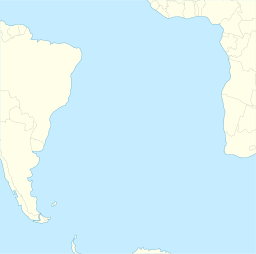Content deleted Content added
No edit summary |
SphericalSong (talk | contribs) m Page has been edited to better reflect the current state of the field by slightly rephrasing some of the existing text, adding information about a competing hypothesis, and adding more accurate references Tag: Reverted |
||
| Line 14: | Line 14: | ||
|coordinates={{Coord|15|44|29.3|S|6|25|52.5|W|display=it}} |
|coordinates={{Coord|15|44|29.3|S|6|25|52.5|W|display=it}} |
||
}} |
}} |
||
The '''St. Helena Seamount chain''', also known as the '''St. Helena Seamounts''', is an underwater chain of [[seamount]]s in the southern [[Atlantic Ocean]]. The chain has been formed by the movement of the [[African Plate]] over the [[Saint Helena hotspot]].<ref>[https://books.google.com/books?id=0z74GC0rA5kC&pg=PA539&lpg=PA539&dq=tristan+hotspot+walvis+ridge&source=web&ots=f4f-g7Z-Wl&sig=SXbPXUvnKiO72Ey2fBYj7T2380s&hl=en#PPA538/M1 Plates, Plumes, and Paradigms]</ref> |
|||
The '''St. Helena Seamount chain''', also known as the '''St. Helena Seamounts''', is an underwater chain of [[seamount]]s in the southern [[Atlantic Ocean]] associated with the [[Saint Helena hotspot]]. Origins of the chain are disputed. One view is that it formed from the [[African Plate]] moving east over a stationary [[mantle plume]].<ref>{{cite book |last=Wilson |first=M. |editor-last1=Storey |editor-first1=B.C. |editor-last2=Alabaster |editor-first2=T. |editor-last3=Pankhurst |editor-first3=R.J. |title= Magmatism and the Causes of Continental Break-up, Geological Society Special Publication No. 68 |publisher=The Geological Society, London |date=1992 |pages=241-255 |chapter=Magmatism and continental rifting during the opening of the South Atlantic Ocean: A consequence of Lower Cretaceous super-plume activity?}}</ref> Another is that it derives from shallow, passive melting along a zone of [[lithosphere|lithospheric]] extension resulting from changes in plate motion and stress fields in response to plate interactions elsewhere.<ref>{{cite web |url=http://www.mantleplumes.org/SAtlantic.html |title=Sea-floor spreading and deformation processes in the South Atlantic Ocean: Are hot spots needed? |last1=Fairhead |first1=D.J.|last2=Wilson |first2=M. |date=2004 |website=www.mantleplumes.org/ |access-date=29 November 2020}}</ref><ref>{{cite book |last1=Fairhead |first1=J.D. |last2=Wilson |first2=M. |editor-last1=Foulger |editor-first1=G.R. |editor-last2=Natland |editor-first2=J.H. |editor-last3=Presnall |editor-first3=J.H. |editor-last4=Anderson |editor-first4=D.L. |title=Plates, plumes, and paradigms: Geological Society of America Special Paper 388 |publisher=Geological Society of America |date=2005 |pages=537-553 |chapter=Plate tectonic processes in the South Atlantic Ocean: Do we need deep mantle plumes? |doi=10.1130/2005.2388(32)}}</ref> |
|||
==References== |
==References== |
||
Revision as of 21:25, 29 November 2020
| St. Helena Seamount chain | |
|---|---|
South Atlantic Ocean | |
| Location | |
| Location | South Atlantic Ocean |
| Coordinates | 15°44′29.3″S 6°25′52.5″W / 15.741472°S 6.431250°W |
The St. Helena Seamount chain, also known as the St. Helena Seamounts, is an underwater chain of seamounts in the southern Atlantic Ocean associated with the Saint Helena hotspot. Origins of the chain are disputed. One view is that it formed from the African Plate moving east over a stationary mantle plume.[1] Another is that it derives from shallow, passive melting along a zone of lithospheric extension resulting from changes in plate motion and stress fields in response to plate interactions elsewhere.[2][3]
References
- ^ Wilson, M. (1992). "Magmatism and continental rifting during the opening of the South Atlantic Ocean: A consequence of Lower Cretaceous super-plume activity?". In Storey, B.C.; Alabaster, T.; Pankhurst, R.J. (eds.). Magmatism and the Causes of Continental Break-up, Geological Society Special Publication No. 68. The Geological Society, London. pp. 241–255.
- ^ Fairhead, D.J.; Wilson, M. (2004). "Sea-floor spreading and deformation processes in the South Atlantic Ocean: Are hot spots needed?". www.mantleplumes.org/. Retrieved 29 November 2020.
- ^ Fairhead, J.D.; Wilson, M. (2005). "Plate tectonic processes in the South Atlantic Ocean: Do we need deep mantle plumes?". In Foulger, G.R.; Natland, J.H.; Presnall, J.H.; Anderson, D.L. (eds.). Plates, plumes, and paradigms: Geological Society of America Special Paper 388. Geological Society of America. pp. 537–553. doi:10.1130/2005.2388(32).
